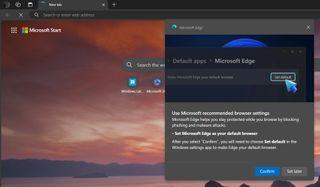Microsoft’s latest attempt to entice Windows 11 users to make a browser switch has left many unimpressed. The tech giant is making a push for its own web browser, Edge, by introducing a pop-up 3D banner that appears on the taskbar for users when they attempt to install an alternative browser. While Microsoft’s intentions may be well-intentioned, the forced nature of this campaign is drawing criticism.
The Windows operating system has long been associated with Microsoft’s own web browser, first Internet Explorer, and now Edge. However, in recent years, Microsoft has struggled to compete with the domination of Google Chrome in the browser market. With Windows 11, the multinational tech company is clearly trying to leverage its latest software version as an opportunity to promote its own browser.
The 3D banner, which pops up on the taskbar during the installation process of a third-party browser, is described as an attempt to educate users and provide them with more information about the benefits of using Microsoft Edge. These banners urge users to reconsider their browser choice and click through to an informational page about Edge.
While it is not uncommon for software companies to promote their own products, the forced nature of this campaign is what has irked many users. Windows 11 users expect to have the freedom to choose which browser they prefer, whether it be Chrome, Firefox, or any other alternative. Microsoft’s attempt to divert their attention to Edge directly challenges this freedom of choice.
Critics argue that Microsoft’s campaign comes across as pushy and invasive. Users should have the right to make their own decisions when it comes to software preferences, without feeling coerced by a persistent pop-up. The 3D banner not only interrupts the installation process but also disrupts the user experience by redirecting them towards a marketing message they may not be interested in.
Additionally, Microsoft’s strategy undermines the competitive landscape of the browser market. By forcing their browser onto users, Microsoft is attempting to regain some of the market share it has lost to competitors. However, this tactic is unlikely to win over users who have already made their browser preferences clear. Instead, it may create resentment and further alienate consumers who value freedom of choice.
Microsoft’s campaign to promote Edge is even more questionable when considering that the browser market is already highly competitive. Chrome, with its dominant market share, offers a host of features and a user-friendly experience that has won over millions of users. Firefox, Opera, and other alternative browsers have also built loyal followings by respecting user preferences. Microsoft must recognize the uphill battle it faces in trying to sell Edge as an appealing choice.
In conclusion, Microsoft’s latest bid to persuade Windows 11 users to switch to Edge through a pop-up 3D banner is receiving significant criticism. The forced nature of the campaign and the intrusion into user choice has left many unimpressed. While it is understandable that Microsoft wants to promote its own browser, forcing it upon users risks alienating them further. The battle for browser dominance should be fought through innovation, features, and user satisfaction, not through pushy marketing tactics.
